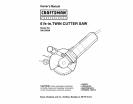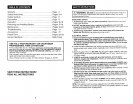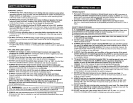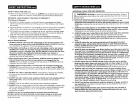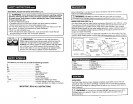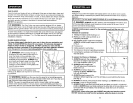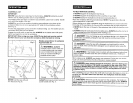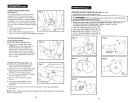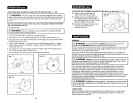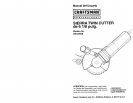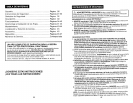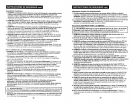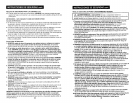
SAFETY RULES FOR SAW cont.
1t, When _emoving the blades from the tool, ALWAYS wear protective gloves when
grasping the blades or accessory. Accessories may be hot after prolonged use.
KICKBACK..,WHAT CAUSES IT AND WAYS TO PREVENT IT
The Causes of Kickback
t. Kickback is a sudden reaction to a pinched, bound or misaligeed saw blades,
which cause the uncont_o!led saw to lift up and out of the workpiece and towards
lhe operator.
2. When tile blades are pinched or bound tightly by the kerf closing down, the blades
stall and the motor reaction drives the unit rapidly back towards the operator.
3. If the blades become twisted or misaIigned in the cut, the teeth at the back edges
of the blades can dig into the top surface of the wood. This causes the blades to
climb out of the kerf and jump back towards the operator.
4. Kickback is a result of tool misuse and/or incorrect operating procedures or
conditions. It can be avoided by taking the proper precautions, as listed below.
Ways to Prevent Kickback
f. ALWAYS maintain a firm grip with both hands on the saw and position your
body and arms to allow you to resist KICKBACK forces, KICKBACK forces can
be controlled by the operator, if the proper precautions are taken.
2. If the blades are binding, or when you are interrupting a cut for any reason,
ALWAYS turn off the saw and hold the saw motionless in the material until
the blades come to a complete stop. NEVER attempt to remove the saw from
the work or pull the saw backward while the blades are in motion or
KICKBACK may occur. ALWAYS check and be ready to take corrective action to
eliminate tile cause of blade binding.
3. When restarting the saw in the workpiece, ALWAYS center the blades in the
kerr end check to be sure that the saw teeth are not engaged into the
material. If the saw blades are binding, they may walk up or KICKBACK from the
workpiece when the saw is restarted.
4. ALWAYS support large panels to minimize the risk of blades pinching and
KICKBACK. Large panels tend to sag under theirown weight. Supports MUST be
placed under tile paoeI on both sides, near the line of cut and near the edge of the
panel.
5. #O NOT use a dull or damaged blades. Unsharpened or improperly set blades
produce narrow kerf which causes excessive friction, blade binding and
KICKBACK.
6. ALWAYS use extra caution when making a "Pocket Cut" into existing walls or
other blind areas. The protruding blades may cut objects that can cause
KICKBACK.
7. ALWAYS have the saw blades at full speed before contacting workpiece
8. ALWAYS keep your body positioned to either side of the saw blades, but not in line
with ti_e saw blades. KICKBACK could cause the saw to jump backwards towards
the operator. KICKBACK forces can be controlled by the operator, if proper
precautions are taken
ALWAYS hold tool by insulated gripping surfaces when performing an
operation where the cutting tool may contact hidden wiring or its own cord.
Contact with a "live" wire will make the exposed metal parts of the tool "live" and
sbock the operator. 6
ADDITIONAL RULES FOR SAFE OPERATION
I Z_ WARNING: BE SURE to read and understand all instructions. Failure to I
follow all instructions listed below may result in electric shock, fire and/or serious
I
personal injury.
1. Know your power tool. Read operator's manual carefully. Learn the
applications and limitations, as well as the specific potential hazards related
to this tool. Following this rule wil! reduce the risk of electric shock, fire or serious
injury.
2. ALWAYS wear safety glasses or eye shields when using this saw. Everyday
eyeglasses have only impact-resistant lenses; they are NOT safety glasses.
Following this rule will reduce the risk of serious personal injury.
3. ALWAYS protect your lungs. Wear a face mask or dust mask if the operation
is dusty. Followingthis rule will reduce the risk of serious personaI injury
4. ALWAYS protect your hearing.Wear hearing protection during extended
periods of operation. Following this rule will reduce the risk of serious personal
injury.
5. ALWAYS inspect the tool cords periodically and if damaged have them
repaired at your nearest Sears Service Center or other Authorized Service
Facility. ALWAYS be aware of the cord location. Following this rule will reduce
the risk of electric shock or fire.
6. ALWAYS check for damaged parts. Before further use of the tool, a guard or
other part that is damaged should be carefully checked to determine if it will
operate properly and perform its intended function. Check for misalignment
or binding of moving parts, breakage of parts, and any other condition that
may affect the tool's operation. A guard or other part that is damaged, should
be properly repaired or replaced at a Sears Service Center. Following this rule
will v_duce the risk of electric shock, fire or serious injury.
7. DO NOT abuse the cord. NEVER use the cord to carry the tool or pull the
plug from the outlet. Keep cord away from heat, oil, sharp edges or moving
parts. Replace damaged cords immediately. Damaged cords increase the risk
of electric shock. Following this rule wil! reduce the risk of electric shock or fire.
8. ALWAYS make sure that your extension cord is in good condition. When
using an extension cord be sure to use one that is heavy enough to carry the
current that your tool will draw. A wire gauge size (A.W.G.) of at least 16 is
recommended for an extension 100 feet or less in length. Using an extension
cord that is over 100 feet inlength is not recommended. If in doubt, use the
next heavier gauge. Smaller gauge wires, have greater capacity (16 gauge
wire has more capacity than 18 gauge wire). An undersized cord will cause a
drop in line voltage, resulting in loss of power and overheating.
9. DO NOT use the tool while tired or under the influence of drugs, alcohol or
any medication. Following this rule will reduce the risk ofelectdc shock, fire or
serious personal injury.
t0.SAVETHESE INSTRUCTIONS. Refer to them frequently and use them to
instruct others who may use this tool. If someone borrows this tool, make
sure they have these instructions also.



